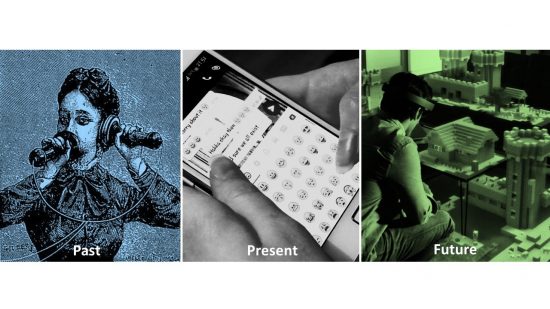What will work look like in 10 years? We’ve heard a lot about the ways new technologies—artificial intelligence, virtual reality, robotics and the like—will disrupt work as we know it.
Will we have a shiny new future, where machines take over menial or repetitive tasks so people can be free to pursue more creative work? Or will AI and robotics take all the jobs, leaving humanity with no meaningful work and a broken economy?
We know from pop culture that we are notoriously bad at predicting the future. Unlike the Jetsons, we don’t zip around with jet packs. No hoverboards from Back to the Future. And 2001 came and went without a computer trying to take over a spacecraft, or the world. And yet we keep trying. And worrying.
Socrates worried 2,500 years ago that by releasing language from the constraints of time and space, the written word would destroy human memory and the art of argument. Today, parents and educators worry that social media is destroying the face-to-face social skills and relationships. In the 1800s, critics of steam locomotives worried that traveling at speeds approaching 50 miles an hour could cause women’s uteruses to fly right out of their bodies! Today, we have growing anxiety about driverless cars—can they be hacked? Will they cause accidents? What will happen to taxi drivers and long-haul truckers?
While we all see the promise of technology, many people see a dystopian future where automation replaces workers and nothing replaces their jobs. Or where drones, facial recognition technology, big data, and analytics are so pervasive that privacy becomes a distant memory.
So what vision of the future do you see? As creators of massive transformation, we need to be thoughtful about how new technologies will challenge and change the ways we work, learn, and interact with others. And we need to be careful about how to lead people along the adoption curve, considering broad social and ethical issues as we develop and shape our society.
As creators of massive transformation, we need to be thoughtful about how new technologies will challenge and change the ways we work, learn, and interact with others. And we need to be careful about how to lead people along the adoption curve, considering broad social and ethical issues as we develop and shape our society.
That is one reason we on the CHILL team are excited to be ramping up our focus on the Future of Work. Technology is changing how, where, and when we work, and we want to be able to anticipate these changes.
Cisco Hyper-Innovation Living Labs (CHILL) represents a unique approach to shaping the future. At our Future of Work lab this coming November, we will compress two years of innovation into two days – winding up at the end of the process with several viable work-related solutions that teams will pitch to senior executives for on-the-spot development funding. To help us prepare, we’re inviting a select group of people from some of the giants of industry to go on a “learning journey” with us next week. We’ll be visiting some of the most innovative companies in Silicon Valley to see how the future of work is shaping up. And we’ll be asking questions focused in three areas:
- How will the worker of the future evolve? What are the changing expectations of future workers? How do the gig economy and talent sharing match supply to demand on an ad hoc basis? What tools do freelancers need for insurance, accounting, and tax preparation?
- How can technology augment the worker? How will artificial intelligence, augmented and virtual reality, robotics, chatbots, and other technologies help humans create orders-of-magnitude improvements in productivity?
- What is the workspace of the future? How does technology change how and where work gets done? Has geographical distribution become irrelevant? Should we be designing and using physical offices differently?
By exploring these and other questions, we’ll be looking for ways not just to predict, but to shape the future of work. If you’re interested in being part of it, we still have a few spots available for our Learning Journey on July 26. Contact Alice Pollard (alpollar@cisco.com) to request an invitation.

A great call to action to consider all possible futures so we can create the one we prefer.
There’s so many exciting technology innovations here. I’m hoping for lots of robots!
Computing power, data access, robust predictive analytics, sensors, and highly advanced devices will allow workers to have incredible access to information/knowledge in near real time. Imagine being able to identify and resolve highly complex issues, problems and risks in minutes rather than hours, days or weeks! Real time collaboration with all requisite data at everyone’s fingertips. Scenario and sensitivity analysis facilitated by AI driving rapid decision making. Increased process automation enabling immediate operational changes and feedback. Identification, analytics, consensus, governance, improvement, execution and results at hyper-speed!
Such an interesting time. What an opportunity we have to dictate how, when and where we want to work.
Terminator and the rise of the machines is pretty much wrinkle free! 🙂